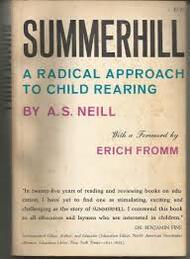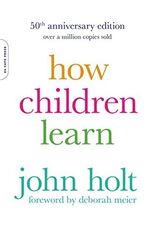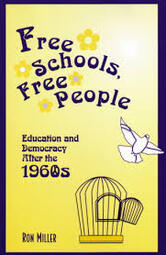 I loved my work at The Free School. I started reading books by alternative education pioneers like John Holt, Ron Miller and A. S. Neill, the founder of the Summerhill School in England. I went to conferences on Alternative education and engaged in fascinating discussions about all of the different models. I learned how to teach effectively, how to reach reluctant students and how to let go of some of my expectations for them. I also learned how to help troubled students deal with their emotions in a safe and healing way. I learned a lot about myself and was forced to look at my past traumas, seeing how they affected my reactions to things in the present. Although I felt as though I had finally found my calling, I also struggled with interpersonal issues in the school. In the early years of my teaching there, an astrologist came through town and offered readings to the teachers. I had experience with astrologers before, including the one who did a chart for Jessie when she was an infant and gave me valuable advice concerning her future health. I decided to go see what he had to say. The most important thing he told me was that, despite the differences I might have with the other staff members and members of the school community, being at the school was a valuable opportunity for me to learn how to work cooperatively in the midst of discord. He said that I would have serious struggles within this community but would come out stronger and wiser as a result. He couldn’t have been more right. I was already struggling with practices that I saw as cultish. Most of the teachers, except for me, lived in the immediate neighborhood and spent most of their time together. Their children all played together and often left out the kids who were not in that neighborhood community. The adults all belonged to an emotional support group that met once a week. I was pressured repeatedly to join the group, and I kept refusing. For one thing, I made a very small salary and spent five days a week in the school, many hours at home preparing my lesson plans or thinking about my students and how best to help them as well as a two to three hour, sometimes more, meeting once a week to talk about the students and other school business. In addition to that, there were board meetings once a month. The teacher’s meetings and board meetings were hard. They were often used to call out someone’s attitude or behavior. They were also used to solve personal problems between teachers. I saw how they would gang up on one person and keep at them until they dissolved into tears. It often felt unreasonable and abusive to me. Because I was not in the emotional support group, I was often involved in some kind of controversy at these other meetings. I would often sit there in dread waiting for someone to bring up an issue they had with me. If I disagreed with the majority, I was often attacked by the whole group. I couldn’t understand why everyone just couldn’t figure out how to get along in the spirit of cooperation and compromise. One time at a board meeting, the founder of the school asked everyone for an honest opinion about her retirement. She was older and mostly uninvolved in the day-to-day workings of the school and had expressed the desire to retire. I listened as everyone told her how valuable she was to the school and community as a whole. I listened as they all encouraged her to stay involved, but also knowing that they all dreaded having her around. The school ran well without her, and we would ask for direction when we needed it. At teachers’ meetings, they repeatedly talked about wanting her to retire but face-to-face, they backed down. When it came around to me, I told her the truth. I said that I respected her immensely and had learned most of what I knew about teaching from her. I also recognized that she had been wanting to retire for a few years but worried that the school would fall apart without her. I insisted that unless she walked away, she would never know. Unless she let the teachers try to run it on their own, we would never learn. I told her that no one was willing to stand up to her and call her out if they thought she was wrong. They were all afraid of her. I was afraid of her too, but I also wanted the school to go on. I reminded her that she could always come back if it didn’t work out. The meeting erupted! The founder, Mary, had always had anger issues, so I knew I was treading on dangerous ground. She got up and screamed inches away from my face, accusing me of trying take her school from her. As if that wasn’t bad enough, all the other board members and teachers jumped on her band wagon and started attacking me as well. I quietly got up and left. Later that night, I got a phone call from Mary apologizing to me. I later learned that after I left, and she calmed down, she turned on everyone else for not defending me. She saw that I was right. No one would ever stand up to her or question her as long as she remained in the community. She was their leader, and they were like sheep. The next day, I was drowning in apologies from everyone, but nothing really changed. I was a rebel and still the outsider, and they remained sheep. Unwittingly, I became the conscience of the school, continuing to call out wrongs that I saw and being the “bad guy” more often than I would have liked. I liked the premise of the school and respected the model. However, it was a different thing in practice. I saw some kids falling through the cracks because there seemed to be no push at all for them to learn. I became aware that this model worked well for the ones who were self-motivated, so I quickly learned how to trick the others. For example, I had one student who came from a violent home and refused to do any schoolwork at all. School was a refuge for him and nothing else. He was ten-years old and couldn’t read or write and knew almost no math. One day, I asked what he wanted to do for work when he was old enough. He told me he wanted work at Stewarts, a local convenience store chain. That afternoon, I stopped by and picked up a job application. The next morning, I handed him the application to fill out. He looked at it blankly. I asked him if he planned to have them fill it out for him at which point, he looked downcast and decided that maybe learning to read was not such a bad thing. Next, I asked him how much of a salary he would need to survive. Again, he looked at me blankly. We talked about rent, utilities and food expenses. That year, he learned to read and write and do basic math. Unfortunately, although he did learn these basic skills, everything else was against him and he ended up in jail later in life, just like his father before him. Working at this school was often as heartbreaking as it was heartwarming. I couldn’t change the conditions in which these kids lived. I loved the fact that there was such economic and racial diversity in the school, but it was also difficult emotionally. It was also hard to go home to my own kids after dealing with serious behavior and emotional issues all day while trying to help educate. Although I believed in child-led learning, I didn’t believe in letting these kids just run wild, distracting the other kids and disrupting their learning. In my classes, I found that I did have certain expectations. Every morning, we did journaling. Those who didn’t want to write or draw in their journals were expected to sit quietly and respectfully while the rest of us did our work, me included. To me, child-led learning meant that they would tell me what they wanted to learn and I would help facilitate that learning whether it meant learning it myself and passing on that knowledge or finding someone else who was more qualified than me to teach it. However, I also recognized that sometimes kids just had to have a year off to do nothing. Time and again, I saw those same kids eventually come around to classes and become increasingly engaged. I had one student who spent most of one school year covering the top of her desk with white glue. By the end of the year, it was a couple of inches thick. Another student, the daughter of two lawyers, also refused to read. She was a wonderful artist, so we let her spend the year doing art. When she finally learned to read at age twelve, she surpassed the others in her class. I never had a problem with letting the students decide what to do with their day. I only tried to stop mayhem from happening. They were allowed to go to the park and play hard, just not in the school building. Every morning the school day started with breakfast then exercises and a school-wide morning meeting. I loved the morning meetings but hated when it was my turn to lead exercises. I didn’t mind doing them, but a lot of the kids didn’t enjoy it and were resistant. The teachers all took turns, which was fair, but I struggled with being creative enough to keep them engaged. The things that I enjoyed were boring to them. Maybe they could sense my own resistance. Whatever it was, I dreaded it every week. However, years later, when the school decided to do away with it, I also missed it terribly. I felt that although I struggled with my role, it was an important way to start off the day. Now there was no sense of community building first thing in the mornings. During the twelve years that I taught in this school, I learned as much as the students did. It’s not always easy to sit back and let your students take the reins. It takes a lot of trust in their natural instincts but also requires a teacher to be intimately involved in their lives, learning how to coax ideas and suggestions out of them, learning to listen to them intently. This means not only listening to their words but listening for the underlying message or watching for clues in their body language. It means being aware of even the subtlest changes in their demeanor or behavior. I learned how to listen with my whole being, not just my ears. I learned to encourage the show of emotions in a safe way, both to the student involved and the others around them. I learned how to let them make their own way without abandoning them but rather being a safety net in case they fell. I learned to trust children to know themselves, their strengths and limitations. And I learned to trust my own instincts as well. I also learned very practical skills for dealing with damaged children such as safe and effective restraining holds. But most of all, I learned patience and trust. Trust in them and trust in myself. After a few years teaching there, I became a co-director responsible for the “upstairs” which was Kindergarten and preschool. I also started coordinating the school lunch program and cooking breakfast in the mornings. I loved coming in early, before everyone else arrived and settling into my day by preparing the food. Breakfast has always been one of my favorite meals to make. Unfortunately, I was not making enough money at the school and started looking for extra work. I answered an ad for a piano teacher at Hilton Music in Troy and got the job. I would go in early on Saturdays and work all day, leaving the kids home with Paul for the day. I was excited to start this new job and get back to my music roots. I also realized that I would not last there forever and wanted to use my new teaching skills in a different venue.
0 Comments
Your comment will be posted after it is approved.
Leave a Reply. |
Archives
January 2024
Categories
All
|




 RSS Feed
RSS Feed